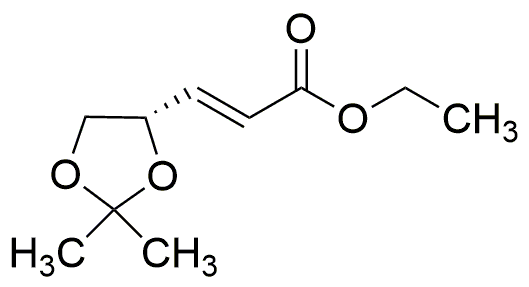Ethyl (S)-(+)-3-(2,2-dimethyl-1,3-dioxolan-4-yl)-2-propenoate is widely utilized in research focused on:
- Flavor and Fragrance Industry: This compound is used as a flavoring agent due to its pleasant aroma, enhancing the sensory experience in food and beverage products.
- Pharmaceutical Development: It serves as an important intermediate in the synthesis of various pharmaceutical compounds, contributing to the development of new medications.
- Polymer Chemistry: The compound is employed in the production of specialty polymers, which are utilized in coatings and adhesives, offering improved durability and performance.
- Agricultural Chemicals: It is used in the formulation of agrochemicals, helping to enhance the effectiveness of pesticides and herbicides, thus improving crop yields.
- Research and Development: This chemical is valuable in academic and industrial research settings for studying reaction mechanisms and developing new synthetic methodologies.
General Information
Properties
Safety and Regulations
Applications
Ethyl (S)-(+)-3-(2,2-dimethyl-1,3-dioxolan-4-yl)-2-propenoate is widely utilized in research focused on:
- Flavor and Fragrance Industry: This compound is used as a flavoring agent due to its pleasant aroma, enhancing the sensory experience in food and beverage products.
- Pharmaceutical Development: It serves as an important intermediate in the synthesis of various pharmaceutical compounds, contributing to the development of new medications.
- Polymer Chemistry: The compound is employed in the production of specialty polymers, which are utilized in coatings and adhesives, offering improved durability and performance.
- Agricultural Chemicals: It is used in the formulation of agrochemicals, helping to enhance the effectiveness of pesticides and herbicides, thus improving crop yields.
- Research and Development: This chemical is valuable in academic and industrial research settings for studying reaction mechanisms and developing new synthetic methodologies.
Documents
Safety Data Sheets (SDS)
The SDS provides comprehensive safety information on handling, storage, and disposal of the product.
Product Specification (PS)
The PS provides a comprehensive breakdown of the product’s properties, including chemical composition, physical state, purity, and storage requirements. It also details acceptable quality ranges and the product's intended applications.
Certificates of Analysis (COA)
Search for Certificates of Analysis (COA) by entering the products Lot Number. Lot and Batch Numbers can be found on a product’s label following the words ‘Lot’ or ‘Batch’.
*Catalog Number
*Lot Number
Certificates Of Origin (COO)
This COO confirms the country where the product was manufactured, and also details the materials and components used in it and whether it is derived from natural, synthetic, or other specific sources. This certificate may be required for customs, trade, and regulatory compliance.
*Catalog Number
*Lot Number
Safety Data Sheets (SDS)
The SDS provides comprehensive safety information on handling, storage, and disposal of the product.
DownloadProduct Specification (PS)
The PS provides a comprehensive breakdown of the product’s properties, including chemical composition, physical state, purity, and storage requirements. It also details acceptable quality ranges and the product's intended applications.
DownloadCertificates of Analysis (COA)
Search for Certificates of Analysis (COA) by entering the products Lot Number. Lot and Batch Numbers can be found on a product’s label following the words ‘Lot’ or ‘Batch’.
*Catalog Number
*Lot Number
Certificates Of Origin (COO)
This COO confirms the country where the product was manufactured, and also details the materials and components used in it and whether it is derived from natural, synthetic, or other specific sources. This certificate may be required for customs, trade, and regulatory compliance.


